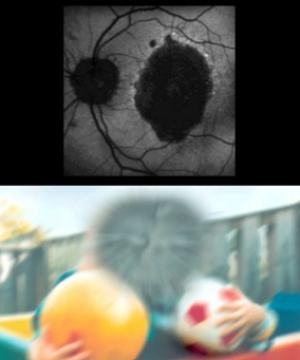The cells were taken from the skin of a patient with macular degeneration, a disease that causes vision impairment, and the Columbia University scientists developed retinal cells from them

An experimental treatment for blindness, based on cells from the patient's skin, improved vision in blind mice. This is according to a joint study by ophthalmology researchers and stem cell researchers from Columbia University.
The findings show that induced pluripotent stem (iPS) stem cells derived from mature skin cells but with embryonic properties - that is, they can become any tissue in the body - may soon be used to restore vision in humans that you have seen deteriorate as a result of macular degeneration and other diseases that affect the retina.
"In eye diseases, we have come close to a situation where cells from the patient's skin are used to replace retinal cells that have been destroyed due to disease or wear and tear," says the lead researcher, Dr. Steven Tsang, professor of ophthalmology and pathology and cell biology. "It is generally said that induced stem cell transplantation will be important in applied medicine in the distant future, but our research shows that the future is almost here."
The development of human induced stem cells in 2007 was received with excitement among scientists who saw it as a way to avoid the ethical complication involved in using embryonic stem cells to create specific cells for the patient. Like embryonic stem cells, the induced cells can become any type of cell. Thousands of different lines of stem cells induced from patients and healthy donors have been created in recent years, but they are used for research or drug screening.
No induced stem cell has been transplanted into humans, but many ophthalmologists say that the eye is the ideal area for induced stem cell healing methods.
"The eye is transparent and is also an accessible place for the central nervous system, which is a big advantage. We can put cells into the eye and monitor them every day in a routine, non-invasive way." Tsang said. "And in case of serious complications, we can remove them from the eye, without endangering the patient's life."
In Dr. Tsang's preclinical experiments, induced stem cells extracted from the skin of a 53-year-old patient were transplanted together with a mixture of growth factors into cells in the retina that lies below the sensory cells of the eye.
The main function of the retinal cells is to nourish the sensitive cells and protect them from excess light, heat and cellular waste. If a retinal cell dies - which happens in various diseases, the light-receiving cells - photoreceptors are damaged and the result is vision loss in old age. It is estimated that about 30% of people suffer from one form or another of macular degeneration, and that the number will double by the year 2020.
In their study, the researchers injected retinal cells derived from induced skin cells into the right eye of 34 mice that suffered from a genetic mutation that caused their retinal cells to degenerate.
In many of the mice, the human stem cells injected into their retinas assimilated without incident and functioned as normal retinal cells even at late ages. The control mice that received injections of saline or inactive cells did not show improvement in the retinal tests.
"Our findings are the first evidence of long-term rehabilitation in a model of retinal degeneration, using cell transplantation, where the improvement in vision is maintained throughout life," Tsang said. "And what is more important is that we did not see the development of cancerous tumors in any of the mice, which is the main concern regarding stem cell transplantation in humans."
Tsang hopes to begin clinical trials in macular degeneration patients within the next three years, after more preclinical trials are conducted in animal models.
Although not a large-scale clinical study, an experimental operation of transplanting stem cells in place of the retina in two patients was able to improve their vision. "The results are encouraging, because induced stem cells will be more attractive than embryonic stem cells because the patient will not have to use anti-rejection drugs for these transplants since they originate from their own body."

7 תגובות
We are in January 2014, how is the investigation progressing, is it possible in Israel to perform eye stem cell transplantation in humans?
If it be, let it be
I don't believe so it probably won't be
I wish it would come true
What about Andrea Rossi? how is he?
What about Andrea Rossi?
Perhaps we are at the threshold of discovering the "medicine" that will contribute the most to human health
In the experiment mentioned in the last paragraph (conducted in the USA and the UK by the American company Advanced Cell Technology) embryonic stem cells are used. So far, 11 patients have been treated, and according to the researchers, the effectiveness of the treatment was noted in most of the patients. As mentioned, so far the official results of the first two patients have been published, and further publication of results is expected in the coming months.